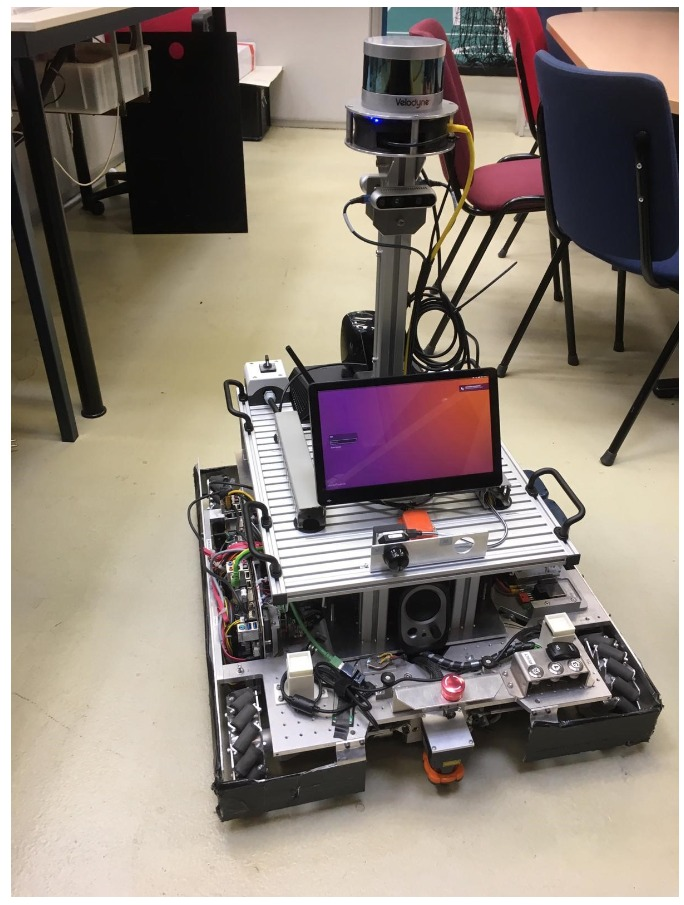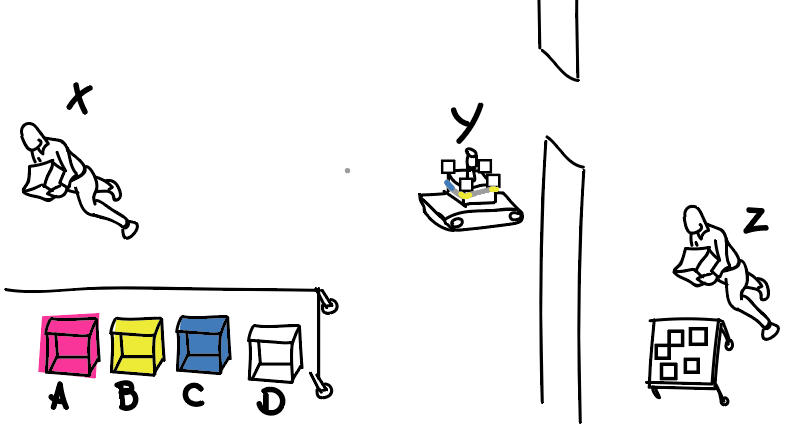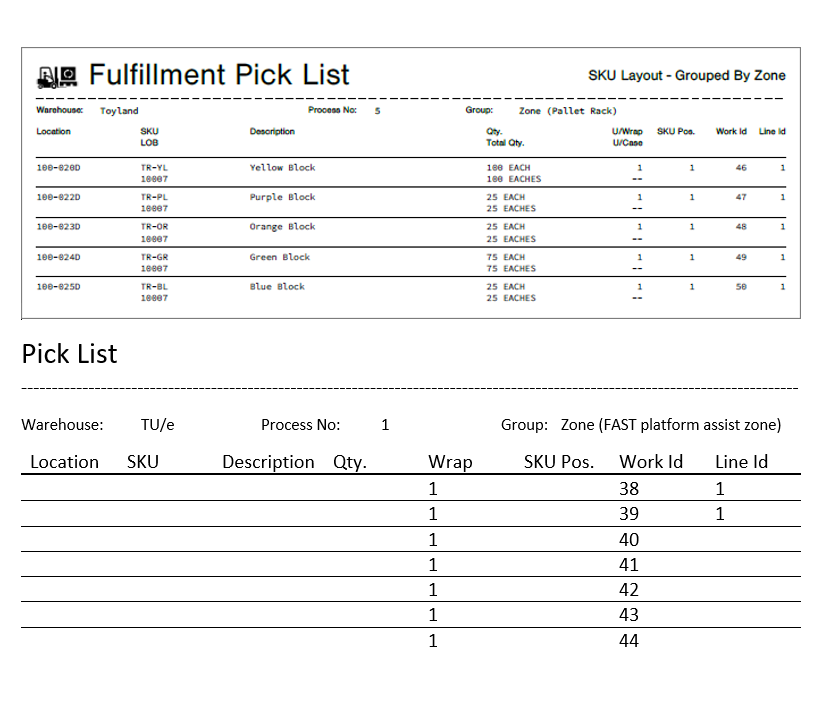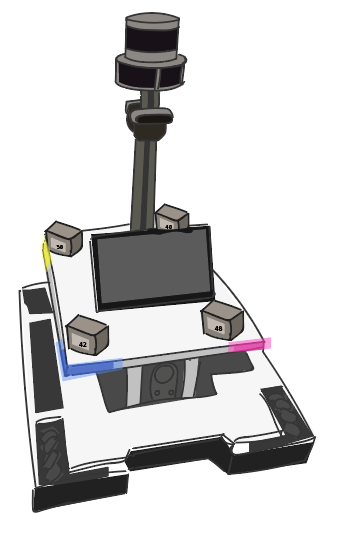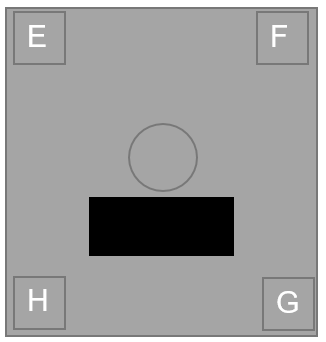PRE2018 3 Group6: Difference between revisions
| Line 192: | Line 192: | ||
With this, we can formulate the following hypothesis for the experiment. | With this, we can formulate the following hypothesis for the experiment. | ||
Hypothesis: Adding a vocal queue or a visual queue to a robot in a warehouse setting will increase the likeability people feel towards it; compared to the likeability they have towards the same robot without these features. | '''Hypothesis:''' ''Adding a vocal queue or a visual queue to a robot in a warehouse setting will increase the likeability people feel towards it; compared to the likeability they have towards the same robot without these features.'' | ||
==Method== | ==Method== | ||
Revision as of 10:33, 3 April 2019
Group members
| Name | ID |
|---|---|
| Pim van Berlo | 0957823 |
| Timo Boer | 0965729 |
| Charlotte Bording | 1246089 |
| Luuk Roozen | 0948743 |
| Panagiotis Kyriakou | 1256416 |
Problem statement
How can the uncertainty humans have about robots actions be reduced, using vocal queues.
- Can a vocal queue help reduce the anxiety people feel, because of uncertainty, towards these robots?
- Does the type of voice have influence? That is a more human like voice or a full on (Steven Hawking) robot voice.
Define Uncertainty:
employees working with robots have trouble understanding the robot.
- They do not know how dumb they are at the moment and give a robot a made-up character and intelligents based on what they know.
- Robot is not competing, trying to be better than human(humans can feel like they have to)(Margot)
- humans don’t understand the robot → feel uncomfortable → can't predict its actions → human stops doing his own task (Margot)
- “The ability to estimate engagement and regulate social signals is particularly important when the robot interacts with people that have not been exposed to robotics, or do not have experience in using/operating them: a negative attitude towards robots, a difficulty in communicating or establishing mutual understanding may cause unease, disengagement and eventually hinder the interaction.” https://link.springer.com/article/10.1007/s12369-016-0357-8
(So in short, People don’t understand what the robot is thinking/doing therefore the human is going to put false assumptions on the robot and will act on those assumptions. Or the human will just stop doing his/her tasks.)
Users
Full rundown of stakeholders involved with introduction of robots in warehouse environments. Since there are many different titles for warehouse workers I’m mentioning the ones that I think that need to be distinguished because of their relationship with the robot.
General Warehouse Laborer
- Description: Responsible for general duties involving physical handling of product, materials, supplies and equipment.
- Education: nothing more than a high school diploma needed.
- Much of their work is moving things around in the warehouse but in smaller scales like forklift drivers.
- Relatively safe (employment wise) since they are the jack of all trades in a warehouse
- Logically their interest is against the introduction of robots and if someone was causing inefficiencies because of the robot introduction it would be them. But since they will be the ones working the most with the robots, it makes sense to believe that they will have a positive stance against the robots having higher speaking skills since their job will be easier and they’ll socialize more.
Forklift driver, material handler
- Description: Operate forklifts to move pallets of products, materials, and supplies between production areas, shipping areas, and storage areas, load and unload trailers
- Education: again nothing more than a high school diploma but this time a forklift driver’s license is required and usually experience is required.
- The main group that will be getting replaced for their transporting role but could still remain because of loading and unloading
- Logically their interest is against the introduction of robots since this is the group that is mostly getting replaced, if one stays, their interest are the same as above
Shipping and Receiving Associate, Warehouse Clerk
- Jobs that mostly have to do with overlooking, organizing and preparing the shipments and with speaking with clients to make new deals respectively.
- Education: again, nothing more than a high school diploma but computer handling skills are required
- This group of employees (not employers) will probably be the one that is going to get affected (replaced or change of responsibilities) the least since they do mostly work with human clients or the make higher level decisions
- I believe their interest again should be somewhere in the middle, since their colleagues are mostly getting replaced but they can do their jobs better since the introduction of robots will bring efficiency. Now for them, that their jobs are fairly stable, it makes sense to believe that they will have a positive stance against the robots having higher speaking skills because they will bring better collaboration and thus their organizing tasks will be easier.
Sources (Links for now) https://www.horizonstaffingsolutions.com/different-types-warehouse-jobs https://www.friday-staffing.com/blog/warehouse-job-titles-and-descriptions/ https://www.indeed.com/
What do the users require?
- users require
- efficiency
- worth of their work
- safety
- robots doing tedious tasks
- time to adapt
- absence of stress
- understandable robots
- Do not require:
- losing their job
- make working with a robot less efficient
- annoying robot
Approach(last edit 2/17)
A qualitative design research.
Trough literature we will broaden our scope of topic. We will look into related work and based on that create a prototype that can give us more knowledge of the issue we are looking into. We will test the prototype on an small group of people(6 to 8) and will evaluate it with them very thoroughly. The results will be analyzed and based on the results together with the literature we will create a discussion and conclusion.
Milestones
- writing introduction,
- prototype finished
- user-test and/or user interview
- using and analyzing results of user-test
- finalizing report - conclusion
- creating presentation
Deliverables
wiki (report)
Final presentation
Interviews
Interview with Margot Neggers (transcript)
Interview with Jilles Smids (recording)
Interview and walkthrough at Eurofrigo a warehouse that does not use robots (visited)
Interview and walkthrough at a warehouse that uses robots (not yet found)
Interview with Bas Coenen (3/11/2019)
Meetings with instruction about the Fast Platform robot (with Ruud van den Bogaert) :
-We have gotten led strips, an Arduino, software library, and sound boxes to use on the robot.
Who does what
- everybody works on writing report
- Charlotte(Industrial design) --> Can do user tests, can help create prototypes.
- Luuk(Web science) --> Can analyze test data, if it is available. Can code for the prototype.
- Timo(Software Science) --> Can also analyze test data, if it is available. Can code for the prototype.
- Pim (Electrical Engineering)
Report
Abstract
Introduction(draft)(last edit 2/17)
Industrial robots are taking over more and more tasks in the workforce. Where there were 1.2 million Industrial Robots around the world, there were 1.9 million in 2017 (West, D. M. (2015). The kind of tasks are usually very repetitive (Tamburrini, G. ,2019), jobs that can be seen as very soul-sucking. The robots are making the process faster and cheaper. For example, robots can work 24 hours a day without getting tired. Robots will take in more space in the workforce, robots are getting smarter, cheaper and are starting to take over more complex tasks (West, D. M. (2015). The transition to robot co-workers can often bring troubles due to the human resistance of robots like humans having trouble understanding the robot, the robot working in a different pace (Weiss, A., et al. 2016) or the fear of being replaced by the robot.(Salvini, P. et al. 2010).
In this research we are looking at creating a more efficient and pleasant transition for the human co-workers by giving the robot a human aspect. It will be tested if a voice, and certain usages of the voice can create more trust and understanding of the robot and therefore less resistance. In a study done by Sauppé, A., et al It is already shown how giving the robot eyes can make its functions clearer for humans (2015). Peoples jobs often change due to the introduction of a robot in their work (Salvini, P. et al. 2010). An application of the voice could be explaining the new tasks in a suitable way. This research will mainly focus on industrial robots in warehouses as this is a very common place where robots are taking over tasks(..., ….)
Citation
Tamburrini, Guglielmo. (2019). Robot ethics: a view from the philosophy of science.
Weiss, A., & Huber, A. (2016). User Experience of a Smart Factory Robot: Assembly Line Workers Demand Adaptive Robots. In AISB2016: Proceedings of the 5th International Symposium on New Frontiers in Human-Robot Interaction.
Sauppé, A., & Mutlu, B. (2015, April). The social impact of a robot co-worker in industrial settings. In Proceedings of the 33rd annual ACM conference on human factors in computing systems (pp. 3613-3622)
West, D. M. (2015). What happens if robots take the jobs? The impact of emerging technologies on employment and public policy. Centre for Technology Innovation at Brookings, Washington DC.
Salvini, P., Laschi, C., & Dario, P. (2010). Design for acceptability: improving robots’ coexistence in human society. International journal of social robotics, 2(4), 451-460.
Related work
In the introduction saw that there is not just an increase in the amount of robots, but also in the difficulty of the tasks they perform. In this section we will cover some of the many works that relate to the problems emerging from these increases. We will also cover research that has been done to specific aspects of our problem.
One of these papers focusses specifically on how helpful vocal interaction can be in learning. In the paper “Effects of voice-based synthetic assistant on performance of emergency care provider in training”[1] the researchers measure whether a person can learn how to provide emergency care more quickly if it receives assistance from a voice-based synthetic assistant. This research paper is related to our work in that it shows that a vocal stimulant can help people in situations that are normally difficult for them to deal with. Giving us an indication that our research might result in a positive outcome.
Another paper that is related to ours is the paper called “Intelligent agent supporting human-multi-robot team collaboration”[2]. This paper gives an in-depth explanation of how an intelligent agent can help humans in their collaboration with robots. This article is especially interesting since one of the scenarios they focus on is warehouses. In this scenario the intelligent agent suggest possibly difficult situations for robots, such as a box that has fallen. The human can then judge whether this hinders the robots or not, and possibly change the robots behavior based on this. At some point the paper discusses whether the human found these suggestions helpful or annoying. Another paper that writes about a robot giving feedback to humans is the paper “Inspector Baxter: The Social Aspects of Integrating a Robot as a Quality Inspector in an Assembly Line”[6]. However this paper focusses on the influence movement and facial expressions can have on the social interaction.
The paper “The Social Impact of a Robot Co-Worker in Industrial Settings”[3], gives a discussion of the social phenomena that emerge when a robot co-worker is introduced in an industrial environment. It does this by discussing the relationship that each employee developed with the robot. In the end it suggests some improvements for future robot implementations that would improve further social interactions. This article relates to our problem in that it discusses the problem but in a broader sense. I.e. not focusing on a specific solution. An paper called “Ripple effects of an embedded social agent: A field study of a social robot in the workplace”[4] also discusses these social phenomenon that emerge in a human-robot cooperative industrial environment. However the robots in this paper perform the same basic tasks as the robots in a warehouse. I.e. picking up goods and delivering them to people.
One paper that we found tries to show the importance of movement in the social interaction between human-robot interaction. As cited “they [robots] also need the ability to model and reason about human activities, preferences and conventions. This knowledge is fundamental for robots to smoothly blend their motions, tasks and schedules into the workflows and daily routines of people. We believe that this ability is key in the attempt to build socially acceptable robots for many domestic and service applications”[5] This relates to our work, because it indicates a variable we need to keep track off.
[1] Damacharla, P., Dhakal, P., Stumbo, S., Javaid, A., Ganapathy, S., Malek, D., . . . Devabhaktuni, V. (2019). Effects of voice-based synthetic assistant on performance of emergency care provider in training. International Journal of Artificial Intelligence in Education : Official Journal of the International Aied Society,29(1), 122-143. doi:10.1007/s40593-018-0166-3 [2] Rosenfeld, A., Agmon, N., Maksimov, O., & Kraus, S. (2017). Intelligent agent supporting human-multi-robot team collaboration. Artificial Intelligence, 252, 211-231. doi:10.1016/j.artint.2017.08.005. [3] Allison Saupp´e, Bilge Mutlu, The Social Impact of a Robot Co-Worker in Industrial Settings, Department of Computer Sciences, University of Wisconsin
[4] Min Kyung Lee, Sara Kiesler, Jodi Forlizzi, Paul Rybski, Ripple Effects of an Embedded Social Agent: A Field Study of a Social Robot in the Workplace, Human-Computer Interaction Institute , Robotics Institute, Carnegie Mellon University, Pittsburgh USA
[5] Gian Diego Tipaldi, Kai O. Arras, Planning Problems for Social Robots, Social Robotics Lab Albert-Ludwigs-University of Freiburg [6] Amy Banh , Daniel J. Rea , James E. Young , Ehud Sharlin, Inspector Baxter: The Social Aspects of Integrating a Robot as a Quality Inspector in an Assembly Line, Proceedings of the 3rd International Conference on Human-Agent Interaction, October 21-24, 2015, Daegu, Kyungpook, Republic of Korea
Research questions and hypothesis
Based on the work already done it is possible to formulate some research questions. The main question will be: “Do vocal queues increase the likeability of a warehouse robot, compared to the use of a so called pick list.” The reason that this is the main research question, is that it covers every problem discussed in the introduction. If people like the robot more, then they are less likely to feel anxious about it.
Since we are able to borrow the robot, and doing the same experiment with visual queues instead of vocal queues. We decided that we would do both. For this reason the second research question is defined as follows: “Do visual queues increase the likeability of a warehouse robot compared to the use of a so called pick list”.
If the answer to either of these two questions is true, then we can look at which method is better. Which is why the third research question is the following: “Do vocal queues increase the likeability of a warehouse robot more than visual queues?”
Now that we have defined some research questions, we can define a hypothesis for the experiment that will be explained a little bit further on. Because of the paper “Effects of voice-based synthetic assistant on performance of emergency care provider in training”[1]. We predict that “Vocal queues increase the likeability of a warehouse robot.” Because of the research Margot Neggers has done, we also predict that “Visual queues increase the likeability of a warehouse.” With this, we can formulate the following hypothesis for the experiment.
Hypothesis: Adding a vocal queue or a visual queue to a robot in a warehouse setting will increase the likeability people feel towards it; compared to the likeability they have towards the same robot without these features.
Method
Figure 2: A drawing of the setup to clarify the explanation given below.
With this method we are trying to see if there is a difference in the interaction with a
warehouse robot when the robot has;
•no communication,
•communicates with lights
•or communicates with voice.
The goal is to get a deeper understanding of human robot interaction focused on voice cues. To do so we will create a scenario were testers have interaction that represents the interaction between man and robot in warehouses.
Definitions
Packets: each packet has a unique number to identify it with; just like in a warehouse. Boxes: each box has a unique color and needs to be filled with certain packets. Subject: The person taking part in the experiment. Denoted by x in figure 2.
Any references to (A), (B), (C), (D), (x), (y), (z) are a reference to their corresponding drawing in figure 2. Thus (y) is a reference to the robot. Experimental setup The robot (y) will start at (z), there researcher (z) will place a packet on each corner of the robot, thus in total 4. An x number of these 4 packets need to be placed by human test subject (x) in the boxes (A) through (D). Test subject (x) has received a list with packet numbers, and a corresponding box color. For example In the list below, the packet with ID 138 needs to go into the blue Box.
Experiment
The robot will drive to the the table containing the boxes (A), (B), (C) and (D). There are three different scenarios. In each scenario the robot (y) uses a different form of communication to aid the test subject (x) in placing the correct packets into the correct box.
Scenario’s In one scenario the test subject (x) has only the list it received at the start to help him/her with finding the right packets for the right box. In an other scenario the robot (y) will use led lights at the side to indicate (using color) in which box each packet goes. It does this by lighting up the corners at which the packet is located in the colors corresponding to the correct boxes. If there is no box on the table matching the color of the led corner, then the box is not meant for human (x). The human (x) can then place the packets in the correct boxes. In the third scenario the robot (y) will use audio communication to indicate which packet goes into which box. It could say, using the speakers, “Packet 138 goes into box blue”. The human (x) can then place this packet in the corresponding box. After the human (x) feels it has finished its job, it will say “Done” and the robot will drive away.
Notes: The person doing the experiment should not be (color) blind, or deaf. Since they would not be able to do all scenarios. The test will be done in "wizard of oz"style. The robot will be remote controlled by us. Since the experiment is about which scenario the subjects find most useful/comforting, and not about testing the capabilities of the robot. Each subject only receives one scenario. Each subject does the experiment three times, each time the number of packets meant for that person will differ.
Procedure plan subject(draft)
Welcome Thank you for taking part in our study. During this study, you will interact with the FAST platform robot. The test simulates order picking in a warehouse. This page provides the rules of the test, Please read them carefully. There will be no practice trail. There will be tree trials in total.
Rule set
Basics:
1. The goal of the trials is to take the packages from the robot and place them in the correct box on the table.
2. After every trial you have to complete a short questionnaire
3. The robot will drive to the marked location on the floor. / Towards you(to create more uncertainty of what the robot will do?) the robot will be carrying (4) packages.
4. When the robot has reached you and stands still, you can take the packages needed and place them in the box.
5. The trail is over when you say “Done”.
Conditions:
o You have to place the packages in the correct box.
Turn procedure:
1. The robot will drive to its marked place / Towards you carrying packages.
2. When it stops, you have to place the packages in the correct box. (Robot says how)??
3. After completion you fill in the questionnaire
4. After the questionnaire you go to the next trial
After reading the rules, you have some time to check out the room.
During the trials we kindly ask you to not ask what is expected from you.
Procedure Plan for Team(draft)
Test subjectX is located in front of a table with 4 boxes colored pink, yellow, blue and white. The robot will start every trial at location z. location z is hidden from the view of subject. In location x the team will have the packages they will put on the robot.
Figure(X): Schematic robot
A list of possible combinations will be created, per trial different combinations will be used.
Example: E 38, F 39, G 40, H 41
Results
Discussion/Conclusion
SotA
Pim
The Human Side of Robotics: How Worker's React to a Robot http://citeseerx.ist.psu.edu/viewdoc/download?doi=10.1.1.462.3947&rep=rep1&type=pdf
Short Summary: An research from 30 years ago that should give a good insight on how expectations match what actually happened. Focusing on the working with robots and the dangers that emerge from it being unsafe.
Toward Safe Close-Proximity Human-Robot Interaction with Standard Industrial Robots
https://dspace.mit.edu/handle/1721.1/106035#files-area
Short Summary: Increasing HRI in the industry will make people work in close-proximity to industrial robots. This article continues on how to make an Industrial robot better for close-proximity interaction.
Robot ethics: Mapping the issues for a mechanized world
https://ac.els-cdn.com/S0004370211000178/1-s2.0-S0004370211000178-main.pdf?_tid=4b18b191-4efd-4bf0-a9e3-526f16e94091&acdnat=1549713537_b2857f75deb01b6954139886023ad36cShort
Summary: This paper focusses on the ethics of robotics in mainly computers and industrialization and how it intervenes with human jobs
Robot Ethics: A View from the Philosophy of Science
short Summary: This paper mentions the factory workers working together with humans and collisions that arise (including robots hurting factory workers and the other way around)
Ethics by Design: A Conceptual Approach to Personal and Service Robot Systems
http://citeseerx.ist.psu.edu/viewdoc/download?doi=10.1.1.105.3665&rep=rep1&type=pdf
Short Summary: Robots in factories are different from what we should have on a day-to-day basis but working together on the same work floor states safety can become an issue. It explores factories a several other work-related robots.
ROBO-PARTNER: Seamless Human-Robot Cooperation for Intelligent, Flexible and Safe Operations in the Assembly Factories of the Future
Short Summary: This article takes an Industry related issue and tries to solve it. Explaining how effective robot-human interaction takes place.
Pepper Game https://pure.tue.nl/ws/portalfiles/portal/109006948/Scheffer_Tim_Report_Pepper_Game_Project_V1.2.pdf
Luuk
Human-robot interaction in rescue robotics https://ieeexplore-ieee-org.dianus.libr.tue.nl/document/1291662
Short Summary: This paper gives an overview about how robots are present at multiple levels of a rescue process. They can help during the search, but also by giving information about an environment that is hard to access by normal people.
Human-Robot Interaction: Issues in the Design of Interfaces for Work in Distant Environments https://journals-sagepub-com.dianus.libr.tue.nl/doi/pdf/10.1177/154193120905300401
Short Summary: This paper talks about the importance of interfaces. They should be simple enough such that they are self-explanatory. However they should also cover all functionality.
Robots in the workplace: Threat or opportunity? https://search-proquest-com.dianus.libr.tue.nl/docview/1807429396
Short Summary: This paper talks about how robots are not as bad as you might think. They do not just cost jobs, but they also create them. And most jobs that are covered by robots, are simple but tedious jobs.
Robots and Machine Vision in Packaging https://doi.org/10.1108/eb004402
Short Summary: This paper talks about how robots help people in the workplace by doing tedious tasks. It describes the robots as “The new robot is a smart, fast, pick‐and‐place device which frees workers to do other tasks.”
People Meeting Robots in the Workplace https://ieeexplore-ieee-org.dianus.libr.tue.nl/stamp/stamp.jsp?tp=&arnumber=5481097
Short Summary: This paper mentions how robots can be used to interact with people. It mentions how it is important for robots to be seen as social. If it is seen as annoying people will not use it no matter how handy it can be. However it is seen as a social creature, people might look past its flaws and actually care for it.
HUMAN-ROBOT FACTORS: ROBOTS IN THE WORKPLACE https://journals-sagepub-com.dianus.libr.tue.nl/doi/pdf/10.1177/154193120605000902
Short Summary: This article describes how robots can help make the workplace better, by doing tedious tasks, it also describes what are important factors in robot acceptance. Such as their ability to do task that are to dangerous for humans, and about how important expectations about this robot are in acceptance.
Charlotte
Weiss, A., & Huber, A. (2016). User Experience of a Smart Factory Robot: Assembly Line Workers Demand Adaptive Robots. In AISB2016: Proceedings of the 5th International Symposium on New Frontiers in Human-Robot Interaction. https://arxiv.org/ftp/arxiv/papers/1606/1606.03846.pdf
Short Summary:
The goal was to find out what kinds of suggestions the assembly line workers – who actually use the new robotic system – propose in order to improve the human-robot interaction the cooperation with a robot that executes predefined working steps actually impedes the user in terms of flexibility and individual speed. that cooperative robots in a dynamic factory context have to adapt to their human co-workers by taking their individual working steps and speed into account.
Buchner, R., Wurhofer, D., Weiss, A., & Tscheligi, M. (2013). Robots in time: How user experience in human-robot interaction changes over time. In Proceedings of ICSR2013, pp. 138-147. https://link.springer.com/chapter/10.1007/978-3-319-02675-6_14
Short Summary:
Our results show an increasing positive UX towards the newly deployed robots with progressing time
Obrist, M., Reitberger, W., Wurhofer, D., Förster, F., Tscheligi, M.: User experience research in the semiconductor factory: A contradiction? In: Campos, P., Graham, N., Jorge, J., Nunes, N., Palanque, P., Winckler, M. (eds.) INTERACT 2011, Part IV. LNCS, vol. 6949, pp. 144–151. Springer, Heidelberg (2011) https://link.springer.com/content/pdf/10.1007%2F978-3-642-23768-3_12.pdf
Short Summary:
(1) Investigate user experience of workers within the factory context. (2) Apply a creative approach, inspired by probing, which is applicable for this context in order to investigate workers’ experiences. on the interaction and user experience (UX) in factories, The results showed that the absence of stress significantly contributes to a perfect working day and that the end of a shift is experienced as the most stressful part of the daily working routine, as this is the most critical point of time for a fluent working process.
Brogårdh, T. (2007). Present and future robot control development—An industrial perspective. Annual Reviews in Control, 31(1), 69-79. https://www.sciencedirect.com/science/article/pii/S1367578807000077
Short Summary:
One scenario is that light-weight robot concepts could have an impact on future car manufacturing and on future automation of small and medium size enterprises (SMEs). Such a development could result in modular robots and in control schemes using sensors in the robot arm structure, sensors that could also be used for the implementation of redundant safe control. Introducing highly modular robots will increase the need of robot installation support,
Sauppé, A., & Mutlu, B. (2015, April). The social impact of a robot co-worker in industrial settings. In Proceedings of the 33rd annual ACM conference on human factors in computing systems (pp. 3613-3622). ACM. https://dl.acm.org/citation.cfm?id=2702181
Short Summary:
workers relate to the robot as a social entity and rely on cues to understand the robot's actions, which we observed to be critical for workers to feel safe when near the robot.
Orendt E.M., Henrich D. (2018) An Architecture for Intuitive Programming and Robust Execution of Industrial Robot Programs. In: Schüppstuhl T., Tracht K., Franke J. (eds) Tagungsband des 3. Kongresses Montage Handhabung Industrieroboter. Springer Vieweg, Berlin, Heidelberg
Short Summary:
Intuitive robot programming and robust task execution. Our architecture enables users to create robot programs by guiding a robot kinesthetically through tasks.
(Dauth, W., Findeisen, S., Südekum, J., & Woessner, N. (2017). German robots-the impact of industrial robots on workers.)
Timo
Robots in Society, Society in Robots
https://link.springer.com/article/10.1007/s12369-010-0066-7
An analysis of human robot interaction and how they are influenced by social and cultural factors. And describes a range of methodologies and design that support a socially robust understanding of technological development/robots
Robot ethics, The ethical and Social Implications of Robotics
An extensive ethical analysis of most branches of robotics. States that human-robot interaction would benefit greatly if robots could express emotions to humans and read emotions shown by humans.
Artificial intelligence and robotics and their impact on the workplace
100+ pages of the effects of robots in the private sector containing: new forms of employment: an analysis of new employment possibilities created by automatization health and safety issues: The interaction between employees and robots and how this will need to change The Impact of New Technology on the Labour Market: A analysis of the jobs that are endangered by automatization and jobs that become more important because of automatization.
Robot ethics: A view from the philosophy of science
This paper analyses the effect of the need for a reduced work force (by automatization). And in particular how people outside the workforce for a lengthy period of time are going to get social benefits as these are usually obtained though employment.
Experimental investigation into influence of negative attitudes toward robots on human–robot interaction
http://rins.st.ryukoku.ac.jp/~nomura/docs/FormalPaper.pdf
A paper exploring the correlation between negative attitudes towards robots and their behavior toward robots. Where they found a gender difference within both negative attitudes towards robots and in the relation between negative attitudes towards robots and their behavior toward robots.
Robots in Time: How User Experience in Human-Robot Interaction Changes over Time
https://link.springer.com/chapter/10.1007/978-3-319-02675-6_14
An analysis of how employees experience their robotic colleagues in a study over time. (week, six months and 1.5 years after implementation of the robot)
